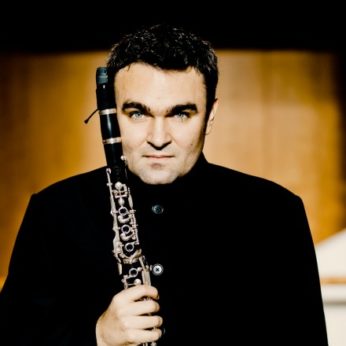Composer: Paul Hindemith (b. 1895 - d. 1963)
Performance date: 30/06/2010
Venue: Bantry Library
Composition Year: 1923/54
Duration: 00:20:54
Recording Engineer: Anton Timoney, RTÉ lyric fm
Instrumentation: vn, va, vc, pf
Instrumentation Category:Clarinet Quintet
Instrumentation Other: cl, 2vn, va, vc
Artists:
RTÉ Vanbrugh Quartet (Gregory Ellis, Keith Pascoe [violins], Simon Aspell [viola], Christopher Marwood [cello]) -
[quartet]
Jörg Widmann -
[clarinet]

Hindemith was one of the composers the Nazis labelled as
degenerate. Most of the so-called Entartete
Musik was written by
composers who were banned simply on racial grounds, but Hindemith’s offence was
entirely musical. Any music the Nazis disapproved of was labelled atonal (even
if it was not), un-German and therefore degenerate, as Rosenberg put it the whole atonal movement is
contradictory to the rhythm of blood and soul of the German nation.
The performance of
his music in Nazi Germany was unofficially banned and the press under Goebbel’s
direction mounted a vitriolic attack on him, which led to Furtwängler’s famous
defence of him – Where will it
lead if we begin to apply the methods of political denunciation to art? For a long time Hindemith seemed
to think that the Nazis were a temporary phenomenon and in 1935 he took refuge
with a teaching post in Turkey, presumably hoping that the German people would
come to their senses. However when his educational treatise The Craft of Musical Composition ended up in the famous exhibition of Entartete Musik in 1938, he realised it was time
to go. In September 1938 he finally left Germany and moved to Switzerland,
still reluctant to leave German-speaking Europe altogether and he only moved to
the United States in 1940.
Hindemith’s Clarinet Quintet was
composed in 1923, directly notated to instrumental parts for a performance with
the Amar String Quartet. Composed during a period of frantic activity in
Hindemith’s life that saw him play over a hundred concerts a year as violist
with the Amar Quartet, it was not until 1954 that Hindemith published a score
for the work, including some major revisions. Like many of Hindemith’s works
the Clarinet Quintet is something of an anachronism, a medley of compositional
languages, simultaneously dark and comic, yet magnificent fun for the listener.
Based on a cyclical structure and
played without a break, the quintet opens with a highly quirky and animated
theme that sees a repeated melodic motif passed back and forward between the
strings and clarinet. The second movement presents a slow and languid passage
for strings; their wandering atonality ameliorated by the clear and animated
melodies of the clarinet, its tone tentatively teasing the strings into
brighter sentiments.
The central
movement uses the E-flat soprano clarinet, normally confined to orchestral and
marching band music. Its mood is raucous, the clarinet soaring high and flighty
over bold, swaggering string passages. The Arioso is an accompanied song for first
violin, its sensuous melody gliding with ease over ominous pizzicato, the
clarinet offering no more than occasional legato interruptions to punctuate the
quartet. The concluding Sehr
lebhaft is the retrograde
form of the first movement, reflective of the same musical events; a surreal
recapitulation that spins us around and spits us out exactly where we
started.
Copyright © 2024 West Cork Music. All rights reserved.
Designed and developed by Matrix Internet